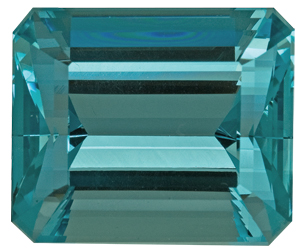|
Colored Gemstone
Positive Forecast for Color
Colored gemstones have been gaining in popularity and it is showing in strong sales.
By Sheryl Jones
 |
| Aquamarine from James Alger. |
As colored gemstones attract more attention — at auction houses, with celebrities walking the red carpet, with designers and retailers and on the internet — they continue to grow in popularity with consumers. During the 2014 Christmas holiday season, dealers report that shoppers showed they are becoming more knowledgeable and sophisticated about gemstones.
As a result, dealers say, customers know what they want: high-quality stones with few inclusions in large sizes and great designs. James Alger, owner of the firm bearing his name, based in Bedford, New Hampshire, says his customers started “shopping strong” for the holiday in the fall and they were looking for the “wow factor,” a combination of great color, quality and precision cuts.
Although rubies and emeralds are the traditional favorites in the colored sector, supply has become an issue for both stones. There is difficulty in sourcing high-quality rubies from Myanmar due to government sanctions for alleged human rights violations there, as well as diminishing supply and a lack of new places to mine. That has greatly affected availability of Myanmar rubies, which has, in turn, increased the value and profile of rubies from such places as Mozambique.
The increasing acceptance of rubies from new locations was confirmed in December 2014 at a Gemfields auction in Singapore. There, rubies from Mozambique, including a 40.23-carat rough ruby stone named the “Rhino Ruby,” helped the company achieve record auction results.
As for emeralds, Colombian emeralds have always fetched the highest prices at auction. According to Andres Schipani, writing in the Financial Times in January 2014, lower production due to mine exhaustion and the resurfacing of old conflicts among the largest miners are affecting pricing and availability of emeralds from that location. Due to their scarcity, there was a reported 30 percent increase in prices for Colombian emeralds in 2014 and they are expected to increase another 25 percent in 2015. As a result of the limited availability of Colombian materials, emeralds from Zambia, which Gemfields says now account for 20 percent of all global emerald production, are gaining in popularity and value.
Anju Baca, owner of Gem Colors, LLC in New York City, says her current customers want high-quality gemstones and in sizes of 20 carats to 30 carats and larger. She says morganite and aquamarine were extremely popular this holiday season and were hard to find in sizes larger than 25 carats to 30 carats toward the end of the year. Garnet was also in great demand and very hard to keep in stock in sizes larger than 15 carats due to scarcity of good-quality rough.
Bernd Stephan, owner of Herbert Stephan KG, a manufacturer based in Frauenberg, Germany, notes the popularity of neutral colored material like mother of pearl and stones in colors of beige, pale blushes of pink and peach, grays and metallic tones like hematite. He says he is seeing a significant increase in demand for his natural stone doublet with mother of pearl on the bottom and a translucent stone like amethyst or blue topaz on top, which creates a luminescent effect.
Colored gemstones in various shades of green also continue to be popular with Stephan’s customers, who order pieces in malachite, chrysophase and untreated green jade. Newly popular in the 2014 year-end holiday season, he adds, was black onyx, especially among his designer clients.
Alger says his customers are also becoming more educated in understanding how treatments of gemstones to enhance color and clarity affect value, since they learn about gemstones on the internet and through high-profile sales. “As a result, there is a 100 percent increase and premium for fine unheated and untreated gemstones,” he says.
Alger, who has been in business for more than 35 years, dealing in sapphires, tourmalines, aquamarines, tsavorites and spessartites, says that he is seeing more demand for traditional, symmetrical shapes in pink spinels, rubies and pink tourmaline, a demand that is strongest in Asia. Baca sees a growing demand for pink tourmaline as well.
Stephan has also seen an increase in demand for finer cuts and makes of stones from his customers. His company, in business since 1932, manufactures and markets black and carnelian agate as well as many quartz varieties, blue topaz and mother of pearl. Stephan points out that “high-end luxury goods companies want custom shapes and cuts as a way to brand in an extremely competitive market. To create complex cuts requires a combination of cutting technology and carving craftsmanship to achieve the desired product.”
Alger says trends reflect people’s moods. “In the 1980s, people were very optimistic. Master Cutter Bernd Munsteiner created futuristic-looking fantasy cuts that were very popular during that time because people were willing to take risks and were in the market for the unusual. Today,” says Alger, “people are more cautious and want safer, more traditional cuts and shapes.”
Wholesalers and manufacturers believe the demand for colored gemstones will continue, with better cuts and high-quality material with superior depth of color bringing premium prices. The February 2015 gemstone shows in Tucson — where Alger and Stephan are both scheduled to exhibit — are expected to reflect the trends from 2014, as well as set the tone for 2015. Article from the Rapaport Magazine - February 2015. To subscribe click here.
|
|